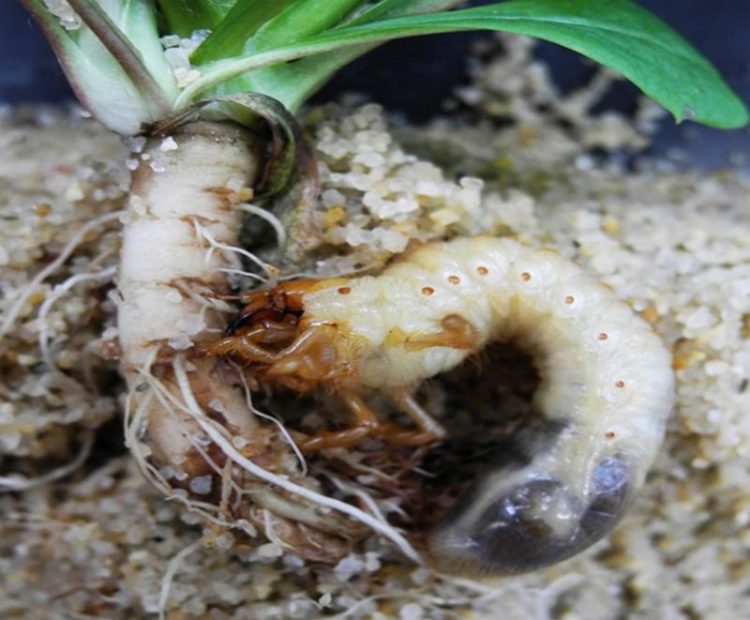The dandelion uses latex to protect its roots against insect feeding

The larva of a cockchafer Melolontha melolontha attacks the roots of a dandelion. Meret Huber / Max Planck Institute for Chemical Ecology, PLOS Biology
Dandelions are survival experts
Dandelions (Taraxacum officinale agg.) are well-known plants of European and Asian origin that have spread around most of the temperate world. Children love their yellow flowers and even more the fluffy seed heads with their parachute-like seeds that can travel long distances by wind. Young plants grow with such force that they can penetrate even asphalt. Therefore dandelions have become a symbol for survival in modern cities.
In fields and meadows, the plant must fend off many herbivores, among them cockchafer larvae. The common cockchafer (Melolontha melolontha) spends the first three years of its life cycle underground as a grub feeding on the roots of different plants. One of its favorite foods is dandelion roots.
Like many other plants, dandelions produce secondary metabolites to protect themselves against herbivores. Some of these defenses, such as terpenes and phenols, are of pharmaceutical interest and are considered promising anti-cancer agents. The most important dandelion metabolites are bitter substances which are especially found in a milky sap called latex, a substance found in almost ten percent of all flowering plants.
Why dandelion latex is bitter
Scientists from the Department of Biochemistry and their colleagues from the University of Bern have now taken a closer look at dandelion latex. The scientists found the highest concentrations of the bitter latex in the roots of dandelions. Dandelions need to protect their roots very fiercely because these are the main storage organs for nutrients which fuel growth early in the spring.
One single defensive chemical protects the plant
The scientists tested first whether latex compounds produced by dandelion roots were negatively associated with the development of cockchafer larvae. They also wanted to know whether these compounds had a positive effect on the fitness and reproductive success of dandelions under Melolontha melolontha attack. An analysis of the components of dandelion latex revealed that one single substance negatively influenced the growth of cockchafer larvae. This substance was identified as the sesquiterpene lactone, taraxinic acid β-D-glucopyranosyl ester (TA-G). When the purified substance was added to an artificial larval diet in ecologically relevant amounts, the grubs fed considerably less.
The researchers succeeded in identifying the enzyme and gene responsible for the formation of a precursor of TA-G biosynthesis, and so were able to engineer plants with lower TA-G. Roots of engineered plants with less TA-G were considerably more attacked by cockchafer larvae. The chemical composition of latex varies between different natural dandelion lines. A common garden experiment with different lines revealed that plants which produce higher amounts of TA-G maintained a higher vegetative and reproductive fitness when they were attached by cockchafer larvae. “For me, the biggest surprise was to learn that a single compound is really responsible for a defensive function,” says Jonathan Gershenzon, the head of the Department of Biochemistry at the Max Planck Institute in Jena. “The latex of dandelions and other plants consists of such a mixture of substances that it didn’t seem necessarily true that one chemical by itself had such a protective role against our study insect.”
The combination of approaches as a key to success
“It was clearly the combination of techniques that was crucial for the success of our studies,” explains Matthias Erb from the University of Bern who led the study. “Each approach has its weaknesses that were balanced by the strengths of the others. We think that this type of interdisciplinary research can be very powerful to understand biological systems.”
The scientists are now planning further experiments study the co-evolution of dandelions and their root herbivores in order of find out whether the presence of root-feeding insects has shaped the plant defensive chemistry in the course of evolution and whether the insects show adaptations to dandelion defenses. [AO]
Original Publication:
Huber, M., Epping, J., Schulze Gronover, C., Fricke, J., Aziz, Z., Brillatz, T., Swyers, M., Köllner, T. G., Vogel, H., Hammerbacher, A., Triebwasser-Freese, D., Robert, C. A. M., Verhoeven, K., Preite, V. Gershenzon, J., Erb, M. (2016). A latex metabolite benefits plant fitness under root herbivore attack. PLOS Biology, DOI: 10.1371/journal.pbio.1002332. Open Access
http://dx.doi.org/10.1371/journal.pbio.1002332
Further Information:
Meret Huber, Max Planck Institute for Chemical Ecology, Hans-Knöll-Str. 8, 07743 Jena, Germany, +49 3641 57-1329, mhuber@ice.mpg.de
Matthias Erb, University of Bern, Institute of Plant Sciences, Altenbergrain 21, 3013 Bern, Switzerland, +41 31 631 8668, matthias.erb@ips.unibe.ch
Jonathan Gershenzon, Max Planck Institute for Chemical Ecology, Hans-Knöll-Str. 8, 07743 Jena, Germany, +49 3641 57-1301, gershenzon@ice.mpg.de
Contact and Media Requests:
Angela Overmeyer M.A., Max Planck Institute for Chemical Ecology, Hans-Knöll-Str. 8, 07743 Jena, +49 3641 57-2110, E-Mail overmeyer@ice.mpg.de
Media Contact
More Information:
http://www.ice.mpg.de/All latest news from the category: Life Sciences and Chemistry
Articles and reports from the Life Sciences and chemistry area deal with applied and basic research into modern biology, chemistry and human medicine.
Valuable information can be found on a range of life sciences fields including bacteriology, biochemistry, bionics, bioinformatics, biophysics, biotechnology, genetics, geobotany, human biology, marine biology, microbiology, molecular biology, cellular biology, zoology, bioinorganic chemistry, microchemistry and environmental chemistry.
Newest articles

First-of-its-kind study uses remote sensing to monitor plastic debris in rivers and lakes
Remote sensing creates a cost-effective solution to monitoring plastic pollution. A first-of-its-kind study from researchers at the University of Minnesota Twin Cities shows how remote sensing can help monitor and…

Laser-based artificial neuron mimics nerve cell functions at lightning speed
With a processing speed a billion times faster than nature, chip-based laser neuron could help advance AI tasks such as pattern recognition and sequence prediction. Researchers have developed a laser-based…

Optimising the processing of plastic waste
Just one look in the yellow bin reveals a colourful jumble of different types of plastic. However, the purer and more uniform plastic waste is, the easier it is to…



